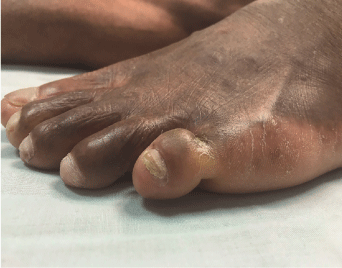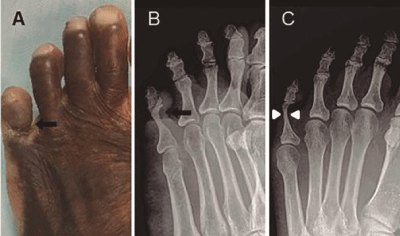
Case Report
Austin J Dermatolog. 2017; 4(1): 1068.
Ainhum (Dactylolysis Spontanea): A Rare Cause of Consult in Dermatology- A Case Report and Review of Literature
González LF¹*, González CA², Motta A1,3 and Rodríguez F4
¹Dermatology Program, El Bosque University, Colombia
²Dermatology Service, Kennedy Hospital, Colombia
³Dermatology Service, Simón Bolívar Hospital, Colombia
4Radiology Service, Colombia Clinic, Colombia
*Corresponding author: Luis Fernando González, Dermatology Program, El Bosque University, Av. Cra. 9 # 131A 02. Bogotá, Colombia
Received: December 19, 2016; Accepted: January 16, 2017; Published: January 19, 2017
Abstract
Ainhum or Dactylolysis Spontanea is an idiopathic condition due to constriction rings or grooves on the digits that result in auto amputation. The ainhum commonly affects the fifth toe and usually the compromise is bilateral. This disease affects mainly African American adults between 20 to 50 years old from tropical and sub-tropical regions. We report a 75 years-old man with clinical and radiographic findings of unilateral ainhum of left fifth toe.
Keywords: Ainhum; Amputation; Dactylolysis spontanea
Introduction
The term ainhum or Dactylolysis Spontanea was used for first time by da Silva Lima in 1867 [1,2]. It is believed that the word “ainhum” derives from the Brazilian word “Nago” meaning ‘fissure’ or the Nigerian word “Yoruba” meaning ‘to saw’ [1]. This condition is a rare cause of consult in dermatology due to the low prevalence; however, the ainhum represents a term of confusion with its counterpart pseudo-ainhum. Ainhum or Dactylolysis Spontanea is used for describe African or African descendent patients with a clinical history of a groove or fissure of constricting tissue around the proximal end of the digits that affects mainly the fifth toe [1]. Meanwhile, pseudoainhum is any case of auto-amputation independent of race that may classify in two spectra ‘primary pseudo-ainhum’ or ‘secondary pseudo-ainhum’ depending the age of presentation and the associated conditions [2]. We report an African American descendent adult with clinical history consisting with classic ainhum or Dactylolysis Spontanea.
Case Presentation
A 75 years old African descendent male from Tumaco, Colombia, is presented to our clinic with a history of 1 year of a groove on the left fifth toe associated to pain and disability. The patient has history of arterial hypertension controlled. On physical examination is observed a constrictive band on the distal phalange of left fifth toe (Figure 1). A skin biopsy was performed with evidence of dermis fibrosis without findings suggested active localized scleroderma. Autoimmune profile was unremarkable, VDRL titers were no reactive and Hansen’s disease was ruled out. Radiographs showed evidence of a constricting band in the middle of proximal phalanx of fifth left toe associated with thinning of bone consisting with ainhum grade III. Figure 2 a surgical management by orthopedic surgery was performed. The pain and discomfort was improved without any important disability posterior to the distal amputation of affected digit.

Figure 1: Physical examination showed a constrictive band on the distal
phalange of left fifth toe.

Figure 2: Patient’s foot (A), and it’s oblique (B) and frontal (C) x ray views.
The constrictive band is seen as a narrowing of the soft tissue in the
proximal phalanx (black arrow in A and B). The bone compromise is evident
as a thinning of the diaphysis compared with the other phalanxes (white
arrowhead in C).
Discussion
Ainhum or Dactylolysis Spontanea (DS) is an idiopathic disease caused by a circular fibrotic constrictive band affecting the digits that result in progressive ischemia and auto amputation [3]. Ainhum may affect any hand fingers [4] or toes [5], commonly the affected digit is the fifth toe and usually this compromise is bilateral [3]. The affected population is African descendent individuals between 20 to 79 years old with a mean age of 52 years [6]. Few cases are reported on seventies like this case. The men are affected more frequently than female with a relation of 2:1, and more prevalent in individuals on barefoot [7]. Ainhum has higher incidence in tropical and subtropical areas among of 0.015% to 3% [3]. In Colombia, there are few reports published, three cases has been reported by Uribe in 1940 and Vélez in 1992 [8], this is the fourth Colombian case reported. However, the incidence and prevalence in Latin America is still underdetermined [4]. In United States, Deccarett et al. [6] reported a prevalence of 1.7% cases of DS in a 6000 African American descendants from Chicago.
The etiology of ainhum is unknown; however, it has related with genetic, infectious, mechanical or inflammatory factors [3,4]. It is believed that ainhum is a skin disorder produced due to a genetic predisposition and fibroplasia that result in a progressive constrictive band as a response to external stimuli such as trauma and infections mainly syphilis and Hansen’s disease, these last ruled out in our patient [6]. However, in the ‘true ainhum’ there is not a real cause associated with the development of circular fibrosis. The histology findings are hyperqueratosis and acanthosis with increase of fibroblasts in the dermis as a response to tissue damage and chronic inflammation [1]. The constrictive band acts as a scar forming a ligature around the toe, this causes a localized anoxia and necrosis that restarts the wound repair process and exacerbates the fibrosis [1]. Hypertension is the most frequent comorbidity associated (like this case) followed by diabetes and peripheric vascular disease [6]. The main differential diagnosis is with pseudo-ainhum, an auto-amputation of the digits that results of an identifiable or associated disease process and is independent of race. Two spectra of pseudo-ainhum has been described: the primary pseudo-ainhum, characterized by a congenital condition presented in the first ages [2] as a result of an identifiable or associated process; and the secondary pseudo-ainhum, characterized by presentation in later in life and associated with keratodermia also named Vohwinkel Syndrome [9], trauma, Hansen’s disease, scleroderma, atypical keratoderma, syringomelia, syphilis, vascular or diabetic gangrene [3].
The diagnosis requires the presence of a circular constrictive band or groove on the affected digit associated with bulbous enlargement of the distal portion, and thinning or lysis of phalangeal bones [3]. Cole et al. [7], described four clinical stages of the disease (Table 1): in the stage I, it is frequent to find a callus or clavus which progresses to a narrow encircling band in the toe [3,7]. The stage II, there is an arterial obstruction with bone resorption and clinically the toe becomes globular distal to the circular groove. In the stage III, the bone is separated from the joint and toe is movable and painful. Finally, the auto amputation due to loss of irrigation of the toe is found in the stage IV [3,7]. The treatment of these patients is based on clinical and radiological stage of the disease. The management of this condition is based on case reports and clinical expertise without clear guidelines to therapeutic approach in these patients. This big gap in the treatment is due to the low prevalence and few cases reported. We summarize the therapeutic options reported in the management of DS on Table 1. Z-plasty surgical procedure, prevention of trauma, and avoidance of ill-fitting shoes is reserved for patients with ainhum stages I or II [6]. Intralesional steroids, salicylate preparations, and retinoid shave been used in early stages [3,7,10]. The prognosis for saving the toe is poor when changes in the bone has observed, like this case, where the surgical amputation is a good alternative to reduce discomfort [6]. Auto-amputation, secondary infections and locomotor imbalance occur in complicate ainhum [3].
Stage of the disease
Clinical examination
Radiographic finding
Treatment
I
Visible groove or area of constriction.
No swelling of the toe.
The groove begins medially and involves the lateral aspect of the toe.
No bone involvement
Rotation is minimal or absent.
Intralesional steroids, salicylates preparations or retinoids [1,7]
Avoid trauma or ill-fitting shoes [3].
II
Bulb enlargement of the toe distal to the constriction.
Toe painful with lymphedema
Visualization of a constricting groove.
Marked external rotation of the toe.
The same of stage I. The surgical management with Z-plasty for releasing the constricting band [1].
III
Severe band of constriction in the distal portion of phalanx of the toe, “dangling toe”
Resorptive bony changes present, the narrowed portion may appear osteoporotic or sclerotic
Definitive treatment is surgical amputation [1].
IV
Spontaneous amputation, bleeding and oozing may occur. Ulcer in the soft tissue at the base of the toe may be present.
The remaining phalanx has triangular “iceberg” shape
Table 1: Clinical staging and therapeutic approach to patients with ainhum [3,6,10].
We report a case of patient with ainhum, a rare cause of consult in dermatology but with high importance to the early detection and effective preventive treatment for avoiding auto-amputation in these patients.
References
- Jemmott T, Foster AV, Edmonds ME. An unusual cause of ulceration: ainhum (Dactylolysis Spontanea). Int Wound J. 2007; 4: 251-254.
- Rashid RM, Cowan E, Abbasi SA, Brieva J, Alam M. Destructive deformation of the digits with auto-amputation: a review of pseudo-ainhum. J Eur Acad Dermatol Venereol. 2007; 21: 732-737.
- Prabhu R, Kannan NS, Vinoth S, Praveen CB. Ainhum - A Rare Case Report. Journal of Clinical and Diagnostic Research. 2016; 10: PD17-PD18.
- De Araujo DB, Lima SM, Giorgi RD, Chahade WH. Ainhum (Dactylolysis Spontanea): a case with hands and feet involvement. J Clin Rheumatol. 2013; 19: 277-279.
- Olivieri I, Piccirillo A, Scarano E, Ricciuti F, Padula A, Molfese V. Dactylolysis spontanea or ainhum involving the big toe. J Rheumatol. 2005; 32: 2437- 2439.
- Daccarett M, Espinosa G, Rahimi F, Eckerman CM, Wayne-Bruton S, Couture M, et al. Ainhum (Dactylolysis Spontanea): a radiological survey of 6000 patients. J Foot Ankle Surg. 2002; 41: 372-378.
- Cole GJ. Ainhum: An account of fifty-four patients with special reference to etiology and treatment. J Bone Joint Surg Br. 1965; 47: 43-51.
- Vélez ID, Vargas J, Valencia C, Wolff JC, Hernández M. Dactilolisis espontanea o ainhum. Iatreia. 1992; 5: 157-159.
- ul Bari A. Keratoderma hereditarium mutilans (Vohwinkel syndrome) in three siblings. Dermatol Online J. 2006; 12: 10.
- Rossiter JW, Anderson PC. Ainhum: treatment with intralesional steroids. Int J Dermatol. 1976; 15: 379-382.